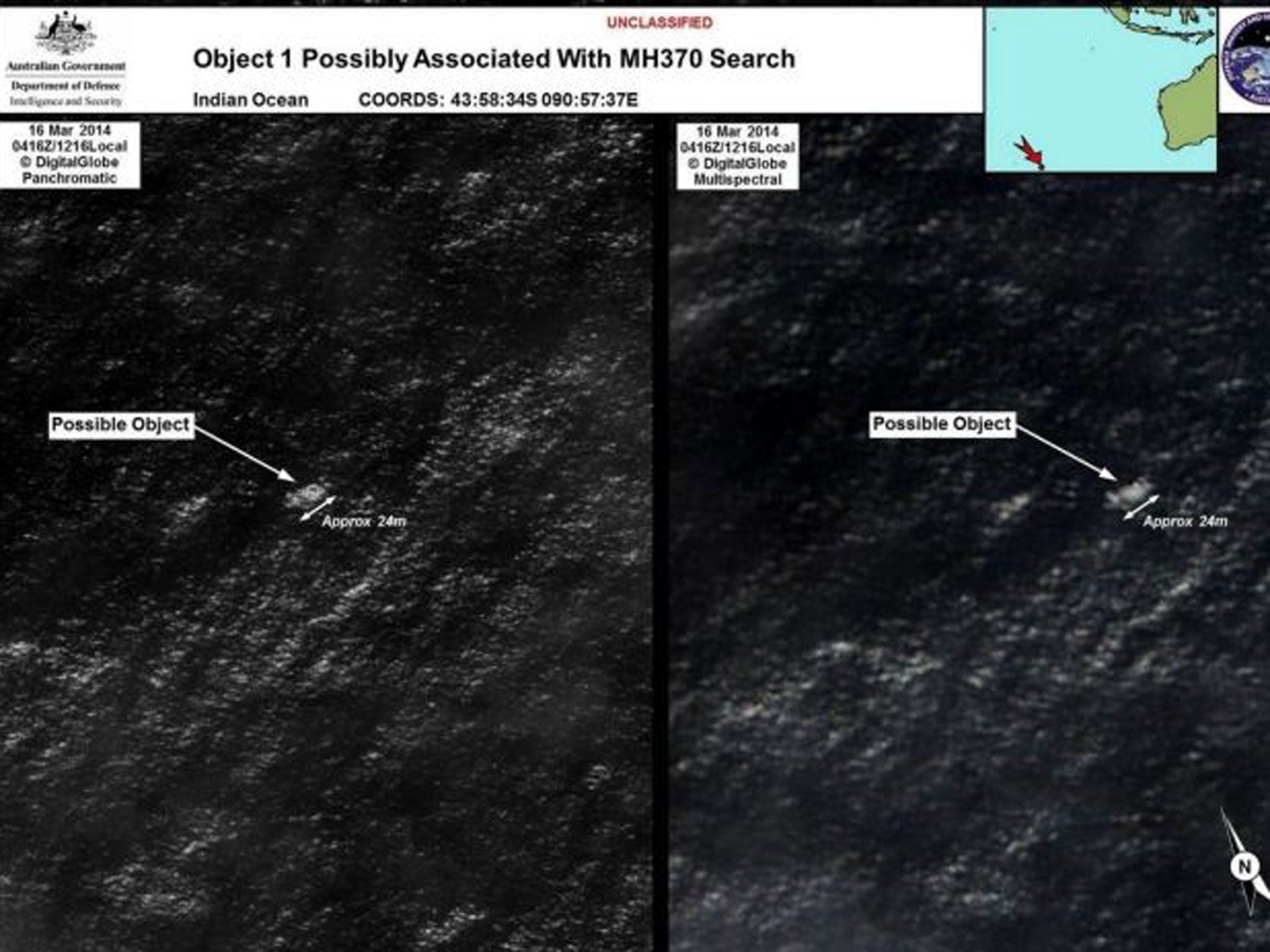Missing Flight MH370: Debris in the Indian Ocean spotted by satellite in hunt for aeroplane
Experts say that the objects could be the aircraft’s fuel tanks or parts of the wing or tail

Your support helps us to tell the story
From reproductive rights to climate change to Big Tech, The Independent is on the ground when the story is developing. Whether it's investigating the financials of Elon Musk's pro-Trump PAC or producing our latest documentary, 'The A Word', which shines a light on the American women fighting for reproductive rights, we know how important it is to parse out the facts from the messaging.
At such a critical moment in US history, we need reporters on the ground. Your donation allows us to keep sending journalists to speak to both sides of the story.
The Independent is trusted by Americans across the entire political spectrum. And unlike many other quality news outlets, we choose not to lock Americans out of our reporting and analysis with paywalls. We believe quality journalism should be available to everyone, paid for by those who can afford it.
Your support makes all the difference.As Australian, New Zealand and US military pilots scoured rough seas in one of the most isolated corners of the globe for two floating objects captured in satellite pictures, experts warned that it could take days to establish whether they are wreckage from the missing Malaysian Airlines flight MH370.
Hopes of a breakthrough in the multinational search for the plane, which vanished off radar screens nearly a fortnight ago, were raised by the Australian Prime Minister, Tony Abbott, who told parliament that the images represented “new and credible information”.
The indistinct objects – one about 24m (71ft) long, the other 5m – were photographed in the southern Indian Ocean, about 2,500km (1,553 miles) south-west of Perth. That was on 16 March, since when they could have drifted hundreds of miles – making the hunt for them a “logistical nightmare”, according to the Australian Defence Minister, David Johnston.
The first planes sent to the area encountered high winds, thick cloud cover and rain, which severely limited their visibility. Other aircraft and ships, dispatched by New Zealand, the US, Malaysia and Britain, were on their way to the spot roughly half-way between Australia and Antarctica, where the ocean reaches depths of 5,000m (16,400ft).

The operation was hampered by the remote location, four hours’ flying time from the Australian coast – giving Royal Australian Air Force (RAAF) aircraft such as the AP-3C Orion just two hours to search before they had to turn back to refuel.
“We are in a most isolated part of the world. In fact, it probably doesn’t get… more isolated,” Mr Johnston told Sky News Australia.
As relatives of MH370’s 227 passengers and 12 crew endured yet another agonising wait for news, the Australian Maritime Safety Authority (Amsa) warned that the objects could be lost cargo from container vessels traversing a busy shipping route.
Jason Middleton, an aviation Professor at the University of New South Wales, told Associated Press: “The chances of it being debris from the airplane are probably small, and the chances of it being debris from other shipping are probably large.”
In recent days, Australia has been co-ordinating operations in a vast sweep of the Indian Ocean identified as one of two main search areas. Investigators believe that the Boeing 777, which vanished on 8 March during a night flight from Kuala Lumpur to Beijing, veered drastically off course – with its communication systems disabled – as a result of deliberate action by someone on board.
The 12-day search has been littered with false leads, misinformation and conjecture. Even now, if the two objects in the blurry satellite pictures are found, and prove to be linked to MH370, that will just mark the start of a long and difficult process of trying to establish what happened to the plane, and why.
For the moment, the pictures are “the best lead we have”, said John Young, manager of Amsa’s emergency response division. He told a news conference in Canberra that the objects were “probably awash with water and bobbing up and down over the surface”.
Trevor Jensen, an aviation consultant, told Australia’s ABC TV that the larger object could be part of the aircraft’s wing or tail (the wing of a 777 is about 27m long). Empty fuel tanks could be “ very buoyant and so… floating to the surface”, Mr Jensen said.
According to Amsa, expert assessment of the satellite pictures indicates a possible “debris field”. An RAAF Hercules aircraft dropped marker buoys at the site, hoping to gather information about currents and wind drift which could help determine the objects’ current location.
In Malaysia, where the government has been criticised for its handling of the investigation, the Transport Minister, Hishammuddin Hussein, said that the images were “a positive development” but “ still must be confirmed”.

For the families of passengers and crew, waiting in China and Malaysia, the pictures were unwelcome. Still clinging to hope that their loved ones might be alive, they prayed that the objects would turn out not to be wreckage, since that would mean the plane had crash-landed and broken up.
In the past two weeks, investigators in Malaysia, assisted by foreign intelligence agencies, have been scrutinising the backgrounds of crew and passengers on the missing jet, but have so far identified no evidence of terror or other potentially relevant links.
Investigators had identified two corridors of territory – one to the north and one to the south – spanning the possible positions of the plane more than seven hours after it took off for Beijing. Earlier this week, Australia was asked by Malaysia to take responsibility for the “southern corridor” search.
Selamat Bin Omar, the father of one passenger, told Reuters: “We do not yet know for sure whether this is indeed MH370 or something else. We are still waiting for further notice from the Australian government.”
David Kaminski-Morrow, air transport editor of the magazine Flight International, was among those counselling caution. “It’s the best lead simply because, with so little information, it’s effectively the only lead,” he told Agence France-Presse.
Join our commenting forum
Join thought-provoking conversations, follow other Independent readers and see their replies
Comments